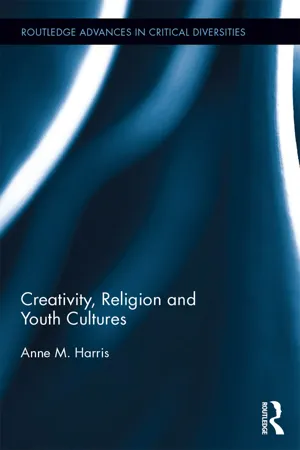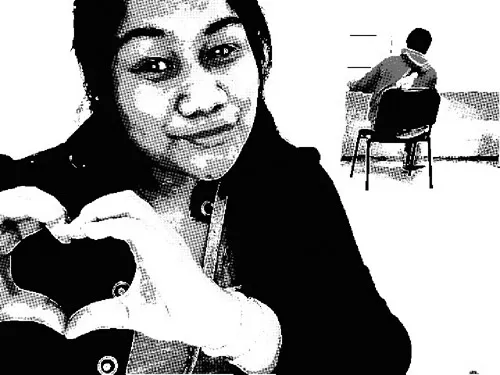![]()
Section 1
Samoan Mediascapes and Faith-as-Performance
![]()
Section 1 Overview
Figure S1.1 Ana showing some digital love. Photo and copyright, Anne Harris.
Overview
The first section of this book is devoted to the Samoan young people who perform their creativity first and foremost through their youth group at the Wesleyan Methodist Samoan Church in Melbourne, and share those performances more widely through social media. This and the Section Two introduction offer a brief overview of the approach and conceptual framings that have helped me think through the work of each youth culture here, and to which I think their particular creative expressions contribute. They also importantly disrupt the way scholarly work in those particular cultural ‘spaces’ has been done. In this first section concerning the Samoan youth, I use their work to think newly about creativity scholarship (O’Connor and Gibson 2014; Runco 2014; Collins 2010; Manning 2009; Barone and Eisner 2011), youth and education studies (Anita Harris 2013; White and Wyn 2013; Youdell 2012; Weis, Fine and Dimitriadis 2009; Dolby and Rizvi 2008; Fine 2008, 2004), and feminist (Ringrose 2015; Braidotti 2013) and critical race scholarship (Singh and Doherty 2008). But each introductory section also shares a bit about my relationship with the young people, as this is intentionally a creative and personal narrative, as well as a scholarly one. Our mutual and sometimes-collaborative work demonstrates the conceptual complexity that can be at the heart of both popular creativity and of “writing-as-research, and the creativity of theorizing our own lives” (Harris and Gandolfo 2013, 3), by jointly exploring these narratives of culture, creativity, and faith through the young people’s commentary, creative writings, images, utterances, and my own.
“Creativity”, Erin Manning tells us, “folds out of thought even as it proposes thought to itself. Thought is an untimely proposition” (2009, 228), and the Samoan young people whose work is featured here are aware of the limits of time in their abilities to actualize the creative thoughts and intensities they experience and share with one another. Temporally overcommitted and under-resourced as so many young people are, these youth multi-task by partly combining their praise practices, cultural and friendship communities, and creative pursuits. The Samoan community in Melbourne, Australia is a sprawling, diverse, but tightly knit group. They are linked closely with other Pasifika peoples (Tongan, Fijian) also living diasporically, an affinity which grows out of many commonalities including cultural, geographic, and religious. Many have come to Australia by way of New Zealand, and many of the youth featured in this case study—like their peers—have been born to Samoan-born parents in New Zealand. So when they talk about culture, many of these young people talk about feeling Samoan, ‘Kiwi’ (vernacular for New Zealanders), and Australian, and indeed they are a mixture of all three in practical and abstract ways. Through their uses of social media, these youth are also building new and extending their communities, into what Appadurai has called ‘communities of sentiment’ (1990), as I discuss later in the book.
Scholarly literature about the Samoan experience is fairly limited. Even historically, much of the extant scholarship represents white colonial, post-war, or western perspectives, as Chi and Robinson (2012) have written about its contemporary history:
Samoa is a group of Polynesian islands in the South Pacific that came under western political control in 1899, when Germany and the United States divided up the islands for themselves. While the German-controlled half gained independence in 1962, the U.S. retained control of the eastern islands.
(61)
As with still so many western narratives, the history begins from European contact. Apart from economic or anthropological studies, of which there are still quite few, works that document contemporary Samoan life are rare. For a general picture of the ill-effects of colonisation in the region, Giuffre is helpful overall; yet it is worth noting that—like so much other literature on Pasifika youth—this work is still generalising, even with the salient cultural analyses here that contribute to readers understanding the Samoan youth in this book and their family histories:
As in the Cooks, annexation and/or colonization often negatively affected the traditional culture. The loss of indigenous language, for example, occurred throughout Polynesia and continues today. The Maori Language Commission poll conducted in 1995 found that only eight percent of Maoris speak a Maori language (Crocombe 2001, 107). Under conditions of colonial rule, it was often advantageous for indigenous people—especially those who could claim mixed ethnic heritage—to identify with the dominant colonial group. With the wave of independence movements that began in the 1960s, the situation throughout Polynesia reversed and those who had formerly identified with the colonial powers now made the most of their indigenous identifiers… . [cultural] fluidity is indicative of a pan-Polynesian indigenous cultural revival that began in the second half of the twentieth century and really gained steam with the first South Pacific Festival of the arts, held in Suva, Fiji, in 1972.
(Giuffre 2009, 72)
Yet a new generation of Samoan-New Zealander and Samoan-American scholars are emerging, among them Samoan-American scholar, activist, and writer Tafea Polamalu, who puts it very differently using a poetic lens that critiques the colonial and anthropological legacy of Margaret Mead and scholarly analyses that have until now been the primary framers of his culture. His poem ‘Diasporic Dream’ (2009) succinctly asserts,
- I know all about Samoa:
- Population
- Climate
- Average life expectancy
- Margaret Mead
- I am the vision
- I am progress
- I am a masterpiece of assimilation.
(2009, 62)
Like Polamalu and other young Samoans, assimilation and cultural maintenance have been an area of great concern for the Samoan youth and their families and church community, as have the material conditions of their diasporic resettlements. Contemporary Samoan stories often tell of frequent exploitative economic, tax, and legislative acts and trends that have left Samoans under-paid and under-employed. Not only in countries of resettlement like Australia, but as Faleomavaega’s discussion of minimum wage in American Samoa and on the American mainland shows, financial inequities are common in Samoan life on a global scale:
Today, most of the estimated 130,000 Samoans or part Samoans residing in the United States live in Hawai’i, California, and Washington. In general, Samoans have higher levels of poverty, and lower rates of home ownership, educational levels, and employment than the general population.
(Faleomavaega 2012, 58)
If there is very little scholarly literature on Samoan lives in general, the experiences of Samoan young women have been almost completely ignored. Important new Samoan scholars are emerging (including Iosefo 2014; Faleomavaega 2012; Polamalu 2009; Tupuola 2004, 2000), highlighting the diversity of this community and the need for more Pasifika scholarship, especially from the global south. I have noted previously,
Like the Samoan American and New Zealander young women of Tupuola’s study, the young women [of Culture Shack] share certain socio-political attributes with some recent feminist and pop culture scholars (Fine 2004) who would have us consider aspects of girl culture more seriously. What Michelle Fine calls ‘empirical archives of social reproduction and struggle’ (in Anita Harris 2004, xiii) show scholars a way forward into new feminist (and pedagogical) geographies, and offer some possibilities for connecting ‘the global ribs that sculpt bodies through gender, race, ethnicity, class, age and geography’ (2004, xiii).
(Harris and Lemon 2012, 429)
Approach to These Collaborations
As O’Connor and Gibson note, Australian cities “are now connected as never before to the emergent horizon of the Asian cities… . However, their ambitions, their vision and their priorities are very far from engaging” (2014, 63) with our Asian neighbours, refusing resolutely to see ourselves as an Asia Pacific country, always culturally gazing toward the west. This disconnect between the strongly Asian population of Australia and its western vision of itself and cultural and economic alliances is evident in the hybrid lives and work of the Samoan youth with whom I have been collaborating since 2005.
The young people who participated in these conversations, interviews, artworks, and filming sessions were all in the end female, although their youth group involves many males and they draw on their shared experiences in this integrated group. The youth featured here and I have been working together in one form or another since I was the drama teacher for some of them, including Vineta, who is my primary Samoan collaborator in this book. The process of self-reflexively and dialogically collaborating through creative and faith-based projects thus began in those classrooms at that all-girls Catholic school in Melbourne’s western suburbs, and to a large extent it is still my primary approach in this project. Pivotal members of both the Samoan and South Sudanese groups of young women and I met this way and have continued through a familiarity that is both educative (certainly not one-way) and mutually enquiring. Coming from a theatre background, I ran my classes as collaboratively as possible, and the works created here were made in this same manner, through a practice-led approach. We have worked across several sites and projects over the years, and I consider them friends as well as collaborators. But this book is specifically about the religious and faith orientations and assemblages of which these young people are participants and practitioners, and much as they have welcomed me into those church and family communities, I am not a member, and I willingly and critically acknowledge that. We have learned much about one another, and others, along these travels, and I expect to continue doing so. But, like Gallagher, I recognise that, “I had to work hard to uncover the taken-for-granted assumptions of my own practice … what I had been was a witness of their telling” (2000, 17).
The young women self-documented their experiences by engaging a range of tools, including video (using phones, flipcams, and approached in a range of ways including ethnocinematic, diaristic, and ethnographic, including filming me) and visual digital tools like Photoshop, Sketch-up, and Flash animation. They are creatively literate with online tools like Vimeo, YouTube, and social media platforms like Snapchat, Instagram, and Facebook, and with their growing literacy, they are circulating their particular creative works in more sophisticated and multi-purposeful ways.
I share their methodology not to artificially decouple their tools from their way of living everyday life, their own doing of things, and the conceptual (and religious and cultural) framework from within which they curate these activities and outputs, but rather to highlight that their tools may be fairly standard in research terms (this could be considered an example of Participant Action Research (PAR) or a visual or multi-sited ethnographic or autoethnographic study), but our collaborative and longitudinal engagement with one another and these explorations of the intersection of cultural, spiritual, and creative aspects of ourselves is a rare privilege and goes beyond any one methodological approach. Like Jean Rouch and his innovations in cine-ethnography, creative and research expansion is possible only through long-term engagement of this kind, and I value our work highly, of which this book is only a snapshot focused mainly around religion. Many researchers (and artists too) never get the opportunity to continue working over a span of many years with the same group of collaborators, particularly with members of fast-moving, over-committed and easily distracted youth communities. Having for many years run community-based arts programs and projects, I know how hard it is to get a group of young people together more than once or twice, given the numbe...

